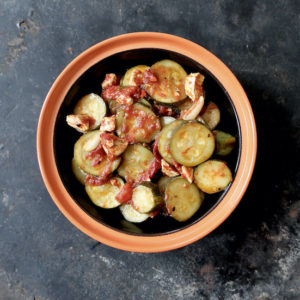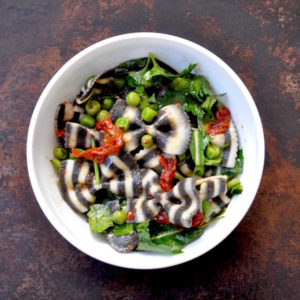Oven-Dried Cherry Tomatoes

We eat seasonally in the IK, though ours is not the precious pastime of snooty Northern Californians. Yes, we live an area of agricultural bounty, making seasonal eating easy and pleasurable. Yet this same location confers a certain responsibility: we have no excuse for consuming fruits or vegetables from across the globe.
Ecological concerns are inescapable here. As I write, California is in the grip of a frightening drought. As for global warming, I need only stand in my yard to view its impact. This is our lemon tree.

In the five years we’ve lived here, it’s fruited prodigiously—in January. Now, in this final week of July, lemons are appearing erratically, unexpectedly, evoking a deep unease.
Beyond planetary concerns lies a desire to mark time. I grew up in the Midwest, where the year was sharply demarcated by weather. But three decades in California have turned me into a lightweight: I know every exquisite fall is followed by a winter filled with blizzards and black ice. And those I do not miss. Instead: tomatoes in July, turnips in January.
Lots of tomatoes in July.
During the summer months I put up a winter’s worth of tomatoes. Yes, this is a needless, potentially insane pursuit (not unlike driving on black ice). Taste trumps these arguments: to preserve your own tomatoes is to know the shortcomings of even the finest commercial products.
Last summer I packed 21 half-pint jars of oven-dried cherry tomatoes in oil. John made fun, but once fresh tomato season ended, he was happy to eat them. A year later, a lone jar remains. Time to start the next batch.
Oven Dried Cherry Tomatoes Packed in Olive Oil
Yield: Two ½ pint jars
1 pint basket organic or pesticide-free cherry tomatoes
olive oil
sea salt
Preheat your oven to 200 degrees F.
Line an 11×17 inch lipped baking sheet with foil. The foil is optional, but makes cleanup easier.
Wash tomatoes. Using a serrated knife, slice each in half. Place on baking sheet with cut sides facing upward.

Placing your finger over the opening of olive oil bottle, drizzle oil over the tomatoes.
Place baking sheet in the oven and allow tomatoes to slowly dry out. This will take about two hours. You want them to become chewy, but not completely crisped. Some may be ready before others; remove them to a plate.
When the tomatoes are finished, allow them to cool completely. Leave the oven on: you’ll use it to help sterilize the jars.
Sterilize two half-pint jars by washing them in very hot, soapy water. I rinse the jars under the hot tap using tongs, then place them in the oven to dry.
While the jars dry, wash and dry jar lids and bands. Use hot soapy water and dry with a clean, non-linting dishtowel.
Once the jars are dry, remove one from the oven using tongs. Place jar on heatproof surface. I use a wooden cutting board. Sprinkle sea salt in the bottom of the jar. Lightly layer in tomatoes until jar is half-full. Do not pack tightly. Add a sprinkling of salt. Fill jar, leaving half-inch headspace at top. Add a little more salt; in total you’ll use about ¾ teaspoon per jar. The salt is there for flavor, so don’t panic over measuring.
Now pour in the olive oil to cover and screw on the lid fingertip tight. You want to be able to open it in six months.
Jars keep, refrigerated, up to a year.
These are wonderful anywhere you’d use fresh tomatoes: in sandwiches, atop a piece of bread with a smear of ricotta, floated in soup, blistered on pizza. We use them most in salads. The olive oil becomes wonderfully permeated with tomato, making a perfect dressing. Pull a jar from the fridge while making dinner, letting olive oil soften to room temperature. Then it’s just a matter of opening the jar and spooning the contents over salad greens.





